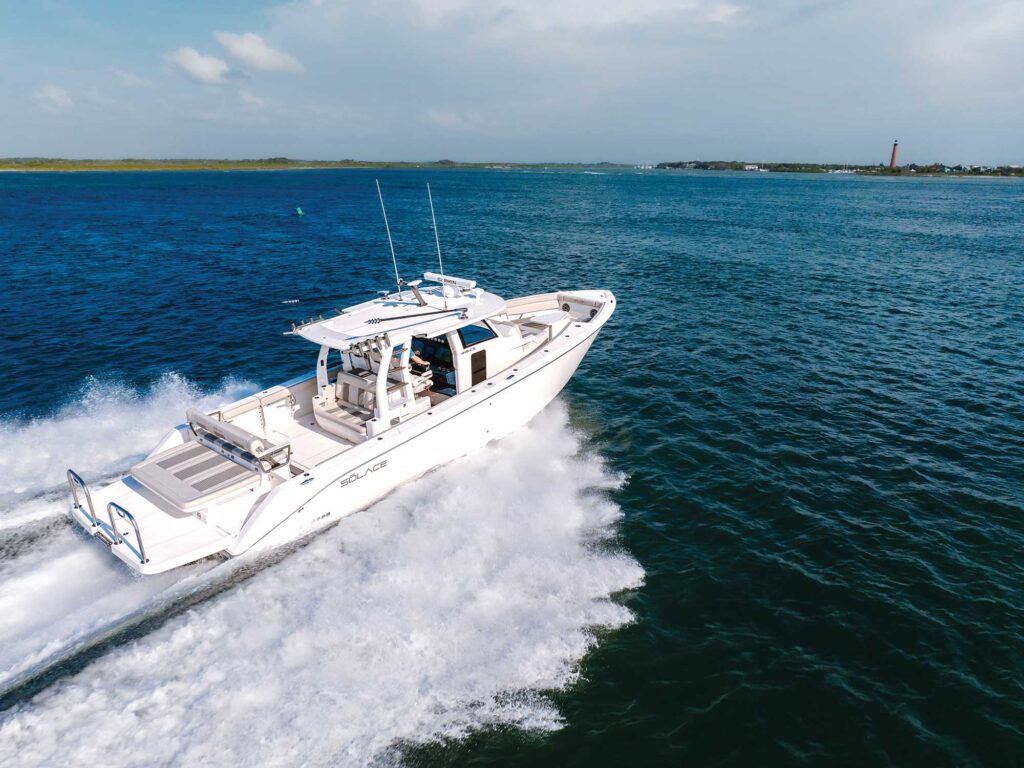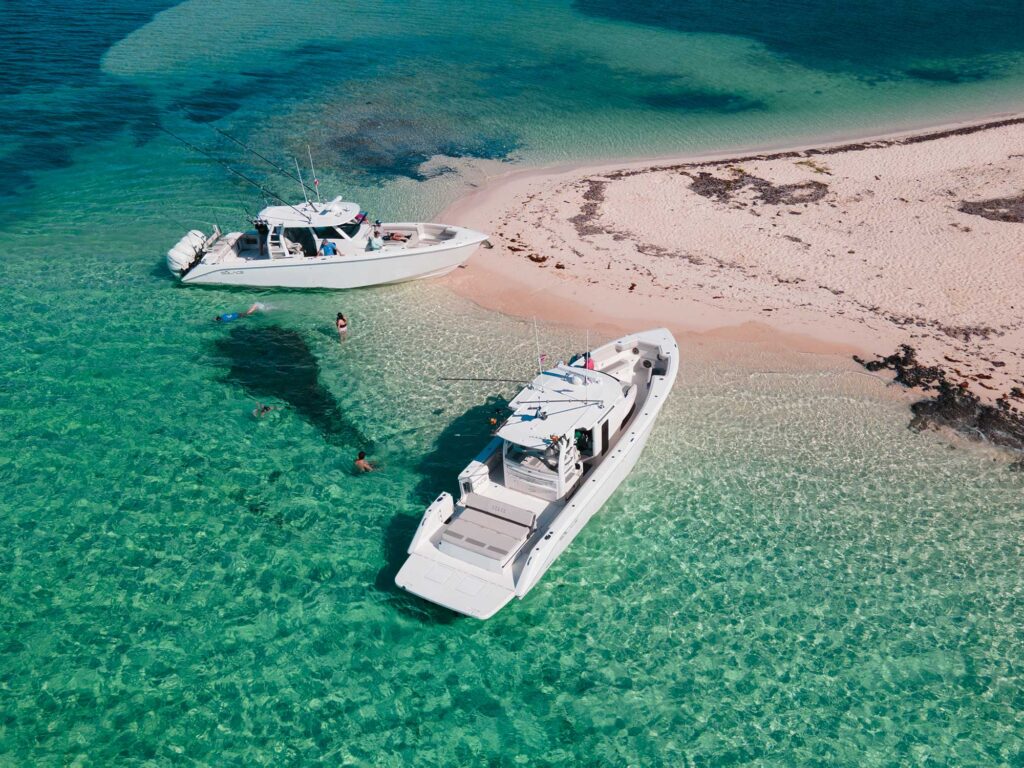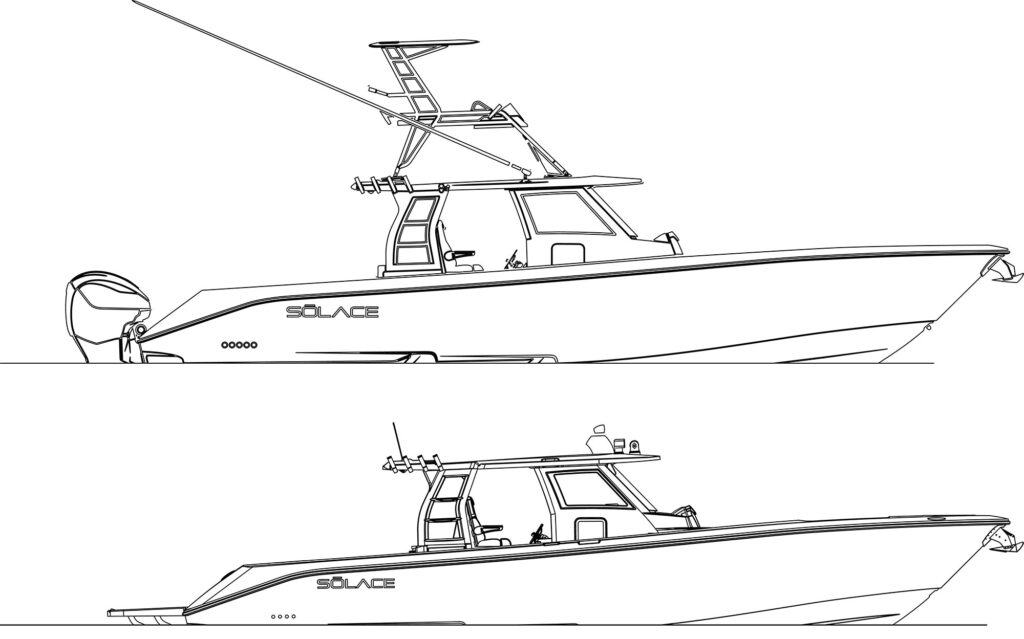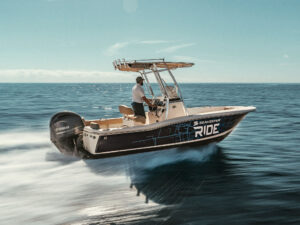
It was a rough wintertime crossing of the Gulf Stream as we powered to the fabled fishing grounds of the Bahamas aboard a pair of Sōlace 41-foot center-consoles. The 41 CS was powered by four Mercury 400 outboards. The 415 CS featured twin Volvo Penta D6 DPI diesel sterndrives. One boat made a better time of it.
This trip was the latest in a string of “Outboard Versus Sterndrive” stories I’d produced over my decades working as a boating and fishing journalist. As in the past, we had planned to compare, out on the water, the different power choices available to boat buyers so that a better-informed purchasing decision could be made. The biggest challenge in producing these “versus” stories is getting access to two of the same-model boat powered by different engines. In Sōlace Boats, we had a great common denominator: These 41-foot hulls are designed and built to the highest standards and can be had with your choice of gas outboard or diesel sterndrive power. Giddyap!
Most of you will recognize that beyond propulsion type, this story also compares fuel type. The outboard Sōlace 41 CS burned gasoline, while diesel fueled the sterndrive-powered 415 CS. Here’s what we discovered regarding seakeeping, fishability, and ownership issues such as maintenance, fuel economy, and price.
Speed and Acceleration
We loaded both boats to the hilt with people, gear, camera equipment, and provisions for a week among the islands. The DPI-powered 415 CS hit 50.6 mph at wide-open throttle. Accelerating to 30 mph took 12.2 seconds. Each DPI turns a stainless-steel H8 Duoprop propset (Volvo Penta does not reveal Duoprop prop pitch) consisting of two contra-rotating propellers spinning through a 1.69-to-1 reduction. So this Volvo Penta D6 DPI diesel propulsion package spins four propellers—two inline pairs.
The outboard-powered Sōlace 41 CS hit 62.7 mph at wide-open throttle and reached 30 mph in 14.5 seconds. Each of the four outboards spins a 14.6-by-21-inch four-blade prop through a 1.75-to-1 reduction. That’s four individual propellers for this outboard-propulsion package.
“Exhilarating” describes the outboard-powered boat’s top speed, a result of more power and more available bow trim. “Surprising” describes our initial reaction regarding the superior acceleration of the boat powered by the Volvo Penta DPI diesels. We attributed this off-the-line performance to the D6’s high torque at low rpm and the Duoprop’s ability to transmit that diesel torque to the water better than conventional props. Finally, the reduced drag of two versus four gear cases helped. Still, if the need for top speed is strong with you, then the outboards win.
Efficiency and Range
Because the power and torque characteristics of gas and diesel engines—as well as inboards and outboards—vary, it is helpful to make efficiency comparisons using boatspeed as well as rpm.
At 25 mph, the outboard boat netted 0.53 mpg and the Volvo Penta boat netted 1.13 mpg. At 30 mpg, the gas boat netted 0.6 mpg and the diesel boat 1.28 mpg. At 40 mph, we recorded 0.63 mpg and 1.2 mpg, respectively. Basically, the diesel boat featured twice the efficiency.
Note that the outboard-powered 41CS carries 681 gallons of fuel, and the 415 CS carries 457 gallons. Also note that each D6 engine with a DPI drive weighs about 1,760 pounds dry, whereas each Mercury 400 Verado weighs in at 670 pounds dry. Bear in mind that an outboard’s power rating describes prop-shaft power, and an inboard’s power rating describes crankshaft power. Each Volvo Penta D6 DPI delivers 422 hp at the prop.
It became apparent the minute we arrived at Abaco Harbor Resort that the Volvo Penta 415 CS offered much more range than the Verado-powered 41CS. The 415 CS still possessed plenty of fuel after making the 215-mile run from Palm Beach. The gas-powered 41CS needed to fuel up so as to have enough fuel to safely conduct our tests over a couple of days. Diesel power lends this boat some 40 percent more range.

Seakeeping
We headed offshore from the Florida coast into the teeth of a stiff headwind that generated 4- to 6-foot seas right on our nose. Both Sōlace models handled the waves safely and with confidence. But our test teams agreed that the Aquamatic-powered 415 CS made easier work of it. Unlike its outboard-powered counterpart with the engine weight aft, the D6 diesel engines turn the DPI drives using jack shafts, which allows installing the engines forward of the transom, under the cockpit sole. Moving the center of gravity results in the 415 CS running more level and with less pitching. The 415 CS handled rough water better.
On balance, we also discovered that the outboard-powered boat offered more bow trim for those times when one wants to optimize the ride for running in a following sea or trying to maximize speed. And the outboard-powered boat proved quieter (65 versus 68 decibels), especially at trolling speeds, though the Volvo Penta boat was by no means loud.
We test for minimum planing speed because the ability to slow down while retaining the maneuverability and dynamic stability provided by planing allows for better control and more comfort in rough conditions than having to slow to trolling speed. The Volvo Penta-powered boat netted a slight edge here, holding plane at 15 mph versus the Mercury boat, which held plane as slow as 17 mph. Know that both are excellent numbers.
Docking
Both Volvo Penta and Mercury offer joystick systems for slow-speed close-quarters operation of the boats they power. Both systems worked well in gusty, tidal Bahamian winter conditions. Do note that as we went to press, Volvo Penta introduced Assisted Docking for DPI, an updated version of its joystick system that uses DPS and special software. I sea-trialed the system (aboard the exact same 415 CS detailed in this story). The big takeaway? It takes the “drift” out of joystick maneuvering and sets a new bar in close-quarters-maneuvering systems.
The Mercury outboards tilt completely clear of the water. Additionally, the outboards are made from a corrosion-resistant aluminum alloy, bonded to control the electrical potential, and feature a multistep coating process called MerCathode. Their successful operation in salt water is long-proven.
“These are not your daddy’s marine engines,” Volvo Penta’s Arjen Steegstra states. The DPI drives are made from a special alloy, bonded to control electrical potential and fitted with sacrificial anodes. The stainless-steel propsets are isolated to prevent corrosion, and a special coating protects the drive. Furthermore, an impressed current anti-corrosion system, the same one that has protected Volvo Penta IPS for years, thwarts the ravages on water-stored boats.
The D6 diesel engines are freshwater-cooled, made from a corrosion-resistant alloy, protected by sacrificial anodes, and specially painted. Volvo Penta D6 diesel engines boast a long history of saltwater service.
Effect on Layout
From the console forward, both of these Sōlace boats are the same, offering private overnight accommodations for a couple, and a comfortable head and shower belowdecks. A large multipurpose bow cockpit forward combines seating with stowage, and functionality for fishing, anchoring and docking is as good as can be found. Aft is where the layout changes. With four outboards mounted on the transom, the cockpit of the 41CS affords a tremendous 83-square-foot unobstructed cockpit. Highlights include twin livewells in the aft corners, and a huge transom fish box to complement those in the aft cockpit sole and the bow space. There is mezzanine seating atop the tackle station/entertainment center, with its stowage, sink and optional grill. There’s hideaway bench seating for three at the transom, and with the huge cockpit and stowage space below the sole—which swallowed provisions for six for a week—the 41CS boasts plenty of room to stow folding chairs and beanbags. The solid transom provides great security for fighting a fish in rough seas. Water access for crew or hauling aboard a big fish is through a generous portside door. This is a fishing cockpit.
The Volvo Penta-powered 415 CS sports twin D6 diesel engines installed in the cockpit, leaving two broad walkways to a transom that is wide open for water access or easy dockside boarding and entertaining. The actual engine box is a plush convertible lounge that allows guests to recline, sit facing forward or aft, or lie completely prone. Unobstructed cockpit space is smaller than that aboard the 41CS—about half the size between the entertainment center and the base of the lounge. You must add in the walkways, though, because they provide another 24 or so square feet of usable space on both sides of the lounge; we had no trouble working rods in the aft corner’s rod holders while trolling.
I will say that the doors that close off each walkway on the 415 CS are less secure compared with the solid bulwark found aboard the 41CS. Excepting the transom livewells and fish box, the fishing accoutrements are the same. The in-sole stowage is smaller aboard the 415 CS, but still plenty big. In short, this is a multiuse cockpit optimized for entertaining and ease of water access that can fish too.
Key Takeaways
There’s little question that the gasoline-fueled outboard engine currently ranks as the most popular power choice for large center-consoles. They run quietly and virtually smoke-free. They deliver outstanding power for their weight, along with low drag and trimmable thrust, all of which contribute to their great efficiency.
That said, I not only fished the Volvo Penta D6 DPI diesel-powered Sōlace in the Bahamas, but also fished it during another multiday trip to the boisterous waters of Nantucket Shoals, Massachusetts. (We absolutely slammed the striped bass!) From these experiences, I can say that diesel sterndrive power is an option that offshore anglers seeking more range and improved seakeeping should seriously consider.

A Tale of Two CCs: Sōlace 41CS and 415 CS
Sōlace is a company founded on open-minded adoption of new materials and processes, many of which have set new industry benchmarks. This is tempered by decades of experience in fiberglass boatbuilding, what the company calls “The Dougherty Difference,” a reference to the current -president, Stephen Dougherty, and his late father, Bob Dougherty. In short, a Dougherty has helmed four different award-winning and iconic boat companies.
With the 41CS and the 415 CS, all of that imagination, vision, experience and expertise is wrought in molded fiberglass. These boats ride a twin-stepped hull that we have experienced to be seakindly, efficient, fun to run, and free from quirks—from New England to South Florida and beyond.
- LOA: 44’3″
- Beam: 12’3″
- Transom Deadrise: 22 degrees
| With Sterndrives | With Outboards |
|---|---|
| Displacement: 22,500 lb. | Displacement: 22,450 lb. |
| Max Power: 880 hp | Max Power: 1,800 hp |
| Fuel Capacity: 457 gal. | Fuel Capacity: 681 gal. |
| Price Base: Twin 440 hp Volvo Penta D6 DPI Diesel Sterndrives – $1,530,105 | Price Base: Quad Mercury V-10 Verado JPO 400 hp Gasoline Engines – $1,558,473 |










